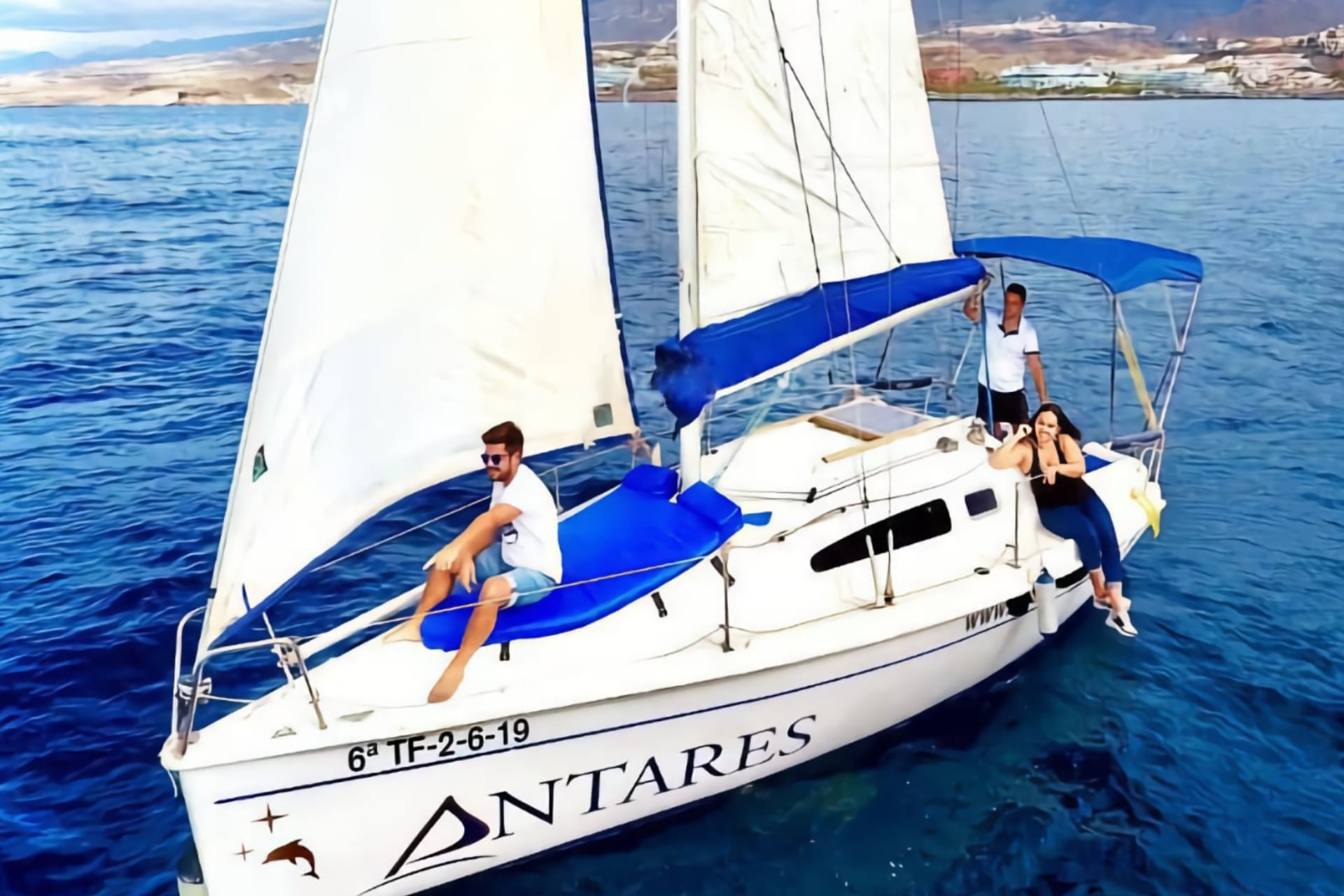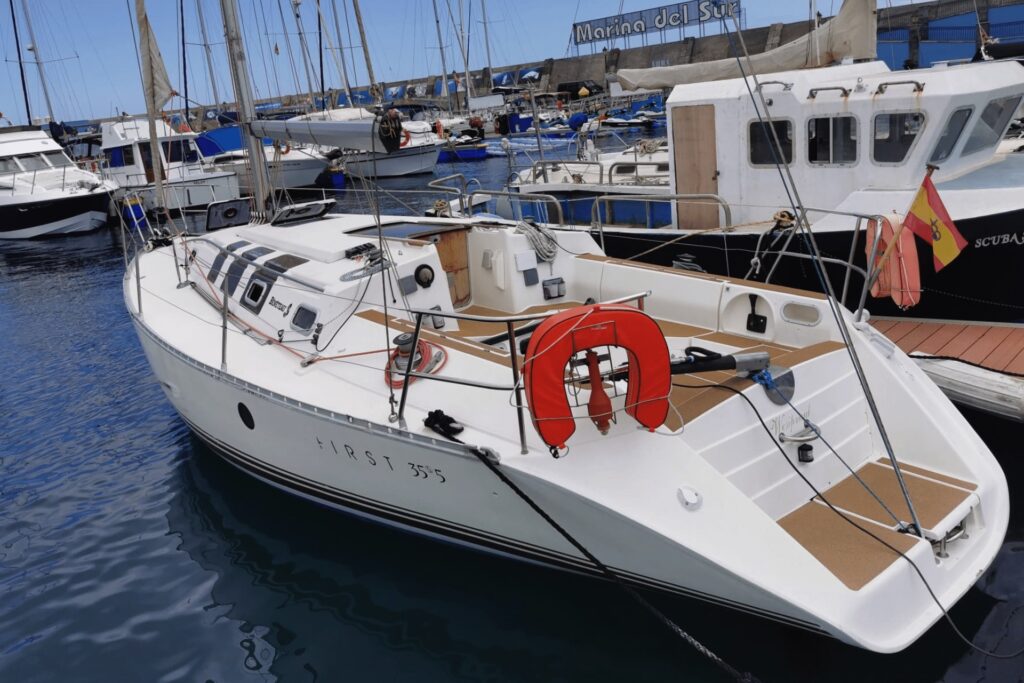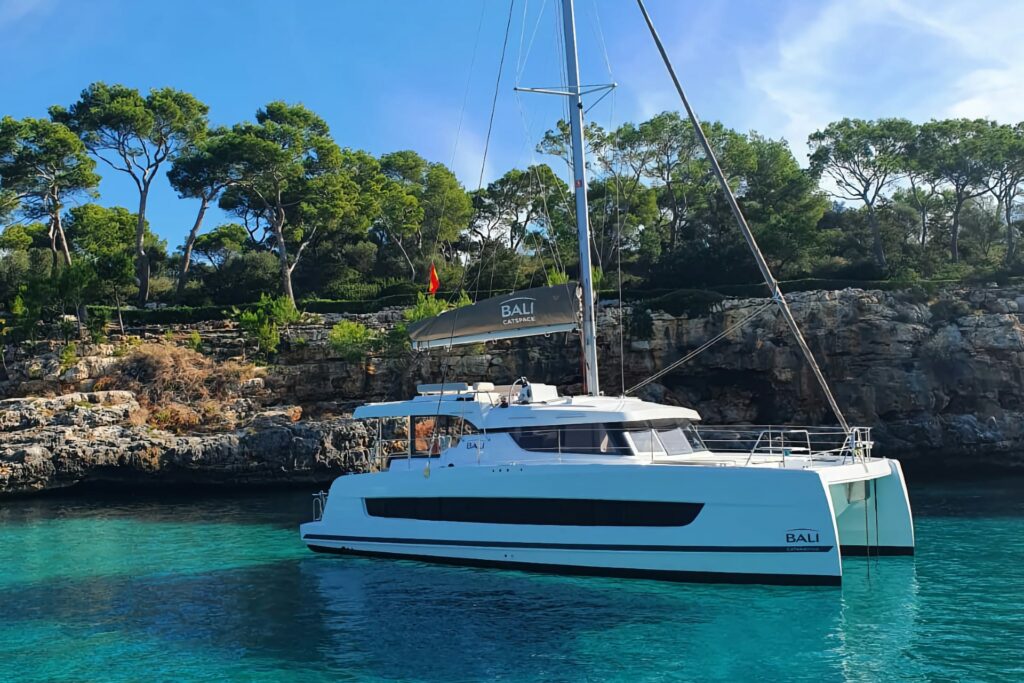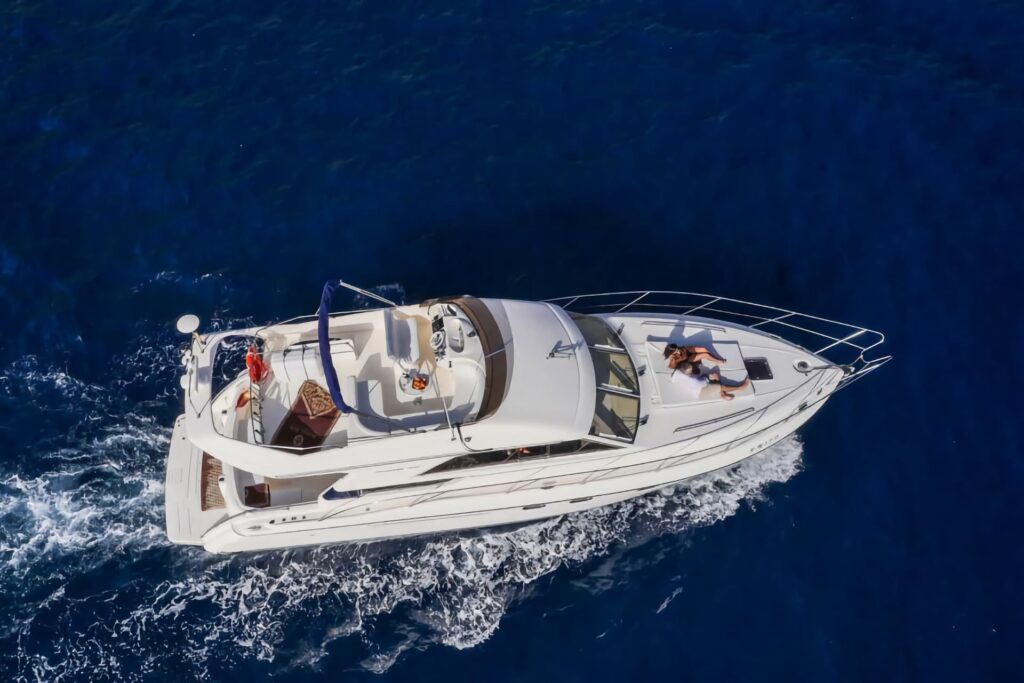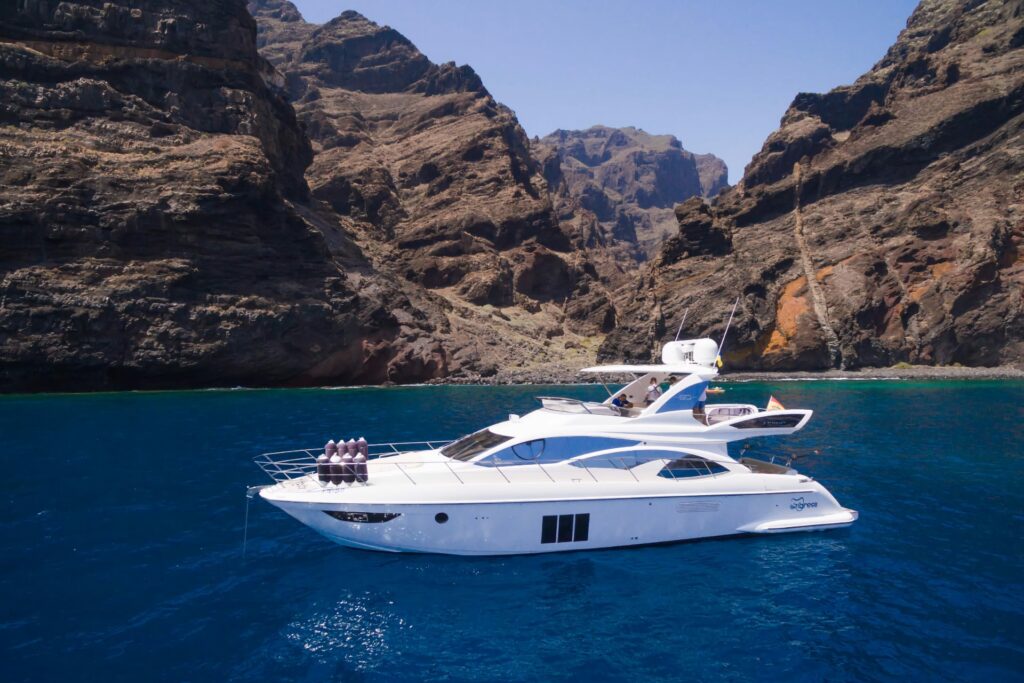Whale and dolphin watching. Tenerife boat trips
Due to the unique subtropical climate, boat trips in Tenerife are possible all year round. You just need to choose a suitable yacht with an experienced captain — yachting in the Canaries is well developed. Of course, it is desirable that the weather is good. And in Tenerife this is the most frequent forecast!
While sailing the ocean on a yacht, you will surely meet local inhabitants, bottlenose dolphins and pilot whales (also called pothead whales or blackfish) enjoying the cool and clear waters of the Atlantic. If you're lucky, you can see other cetaceans (read below which ones), as well as sea turtles.
Choose a yacht that you like and that fit your budget! Also, we can offer you a fishing boat trip.
Yachts and boats for sea trips
Who you can meet during a boat trip: whale and dolphin watching (Tenerife, Costa Adeje)
Fresh breeze, bright sun, blue waves and bottomless sky… What else can you expect from an ocean boat trip? Of course, marine life watching! During an excursion in the Atlantic, you will most likely be able to observe two species of cetaceans, which live in the waters of the Canary Islands all year round: the pilot whale and the bottlenose dolphin. Boat Tenerife rental allows you to see them in their natural habitat with a very high probability.
Sometimes other species of whales and dolphins can be found in the ocean. In total, up to 32 species of marine mammals have been observed by experts in the Canary Islands over the years. The reason for this diversity lies in the volcanic origin of the islands: in fact, a volcanic island is a mountain that arose from the ocean, and the slopes under water are as steep as those of volcanoes above the ground. The depth between the islands is up to 3000 meters. In addition, in the area of the Canary archipelago there are the southern border of the habitat of species that prefer cold waters and the northern border of the habitat of species that prefer warm tropical waters. Consequently, during the periods of seasonal migration, both can be found here. But let's first get acquainted with those for whom the Canary water area is home. It’s better to know them before the excursion for the best whale and dolphin watching Tenerife can offer.
All you need to know
- Which dolphins and whales will you definitely see?
- What other dolphins can be found around Tenerife?
- Whales occasionally entering Tenerife's waters
- What time of year is it possible to see more dolphins in Tenerife?
- What is the best time of day to see dolphins and whales?
- Are boat trips safe for marine life and ecology in Tenerife?
- Rules for the observation of cetaceans in Tenerife
- How exactly and where can you see whales and dolphins?
- Where does the dolphin trip start from?
- What are the chances of seeing whales and dolphins in Tenerife?
- Is it possible to swim on a boat trip? What can you see underwater?
- What else is included in the price of a boat trip to Tenerife?
- Is it possible to have a party on a yacht in Tenerife?
- Is there any danger in boat trips in Tenerife?
- Can seasickness start while sailing on the ocean?
- What should I take on a boat trip to Tenerife?
- Other exciting activities in Tenerife
Bottlenose dolphins
Bottlenose dolphins (Tursiops truncatus) are often found at the beginning or at the end of a boat trip in Tenerife (since they live relatively close to the shore), surprising observers with graceful jumps, agility and speed. Bottlenose dolphins can reach speeds of up to 40 kilometers per hour and jump to a height of up to 5 meters.


The average size of an adult is 2.5–2.7 meters. The largest bottlenose dolphin seen in the Canaries had a length of 3.4 meters. Bottlenose dolphins can live for about 30 years and weigh 500 kg. They live in groups of 10–30 dolphins, and males usually keep separate from females and offspring.
The back is dark gray, turning into lighter shades (up to white) on the lower jaw and abdomen. There is a blowhole on their back through which they breathe. In this regard, bottlenose dolphins need to rise to the surface at least every 5–8 minutes.
The probability of seeing bottlenose dolphins during a boat tour in Tenerife is about 70–80 %. It is not difficult to recognize them, since this is the most famous species of dolphins, in particular, thanks to the movies.
Pilot whales
Pilot whales (Globicephala macrorinchus) or blackfish are large oceanic dolphins living all over the globe.
The length of an adult pilot whale can be more than five to six meters, weight may vary from 1000 to 4000 kg. The color ranges from dark gray to black, often with white spots on the abdomen.
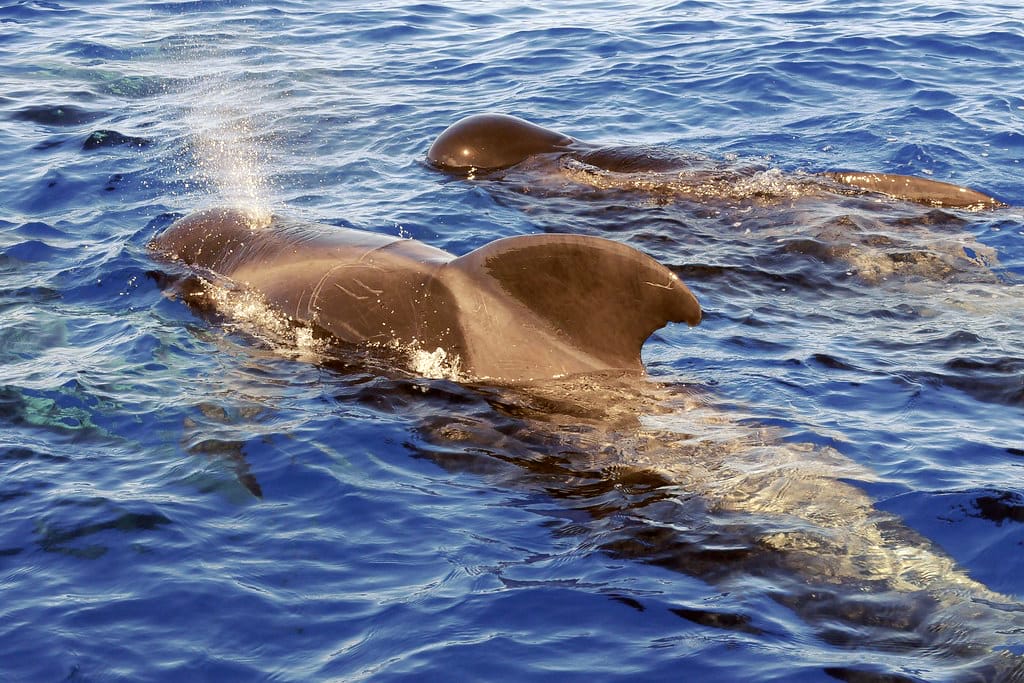

Pilot whales are very friendly. They live in groups of 30, and sometimes 60 individuals, within which they constantly interact with each other, play, communicate. They often approach boats with great curiosity.
The probability of meeting pilot whales during a boat trip near Tenerife is more than 95 %.
What other dolphins can be found around Tenerife?
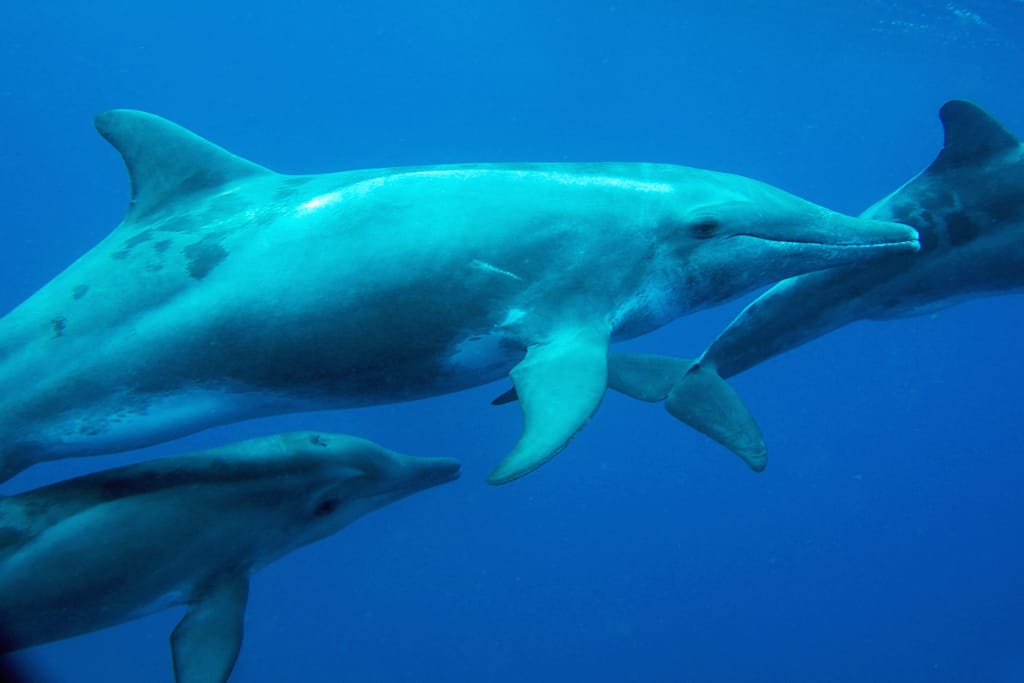

The rough-toothed dolphin (Steno bredanensis) has a darker color than the bottlenose dolphin, which is especially noticeable in contrast with the light spots on the body. There are grooves on the teeth, the skull is elongated. Length is up to 2.7 meters, weight is up to 150 kg. Compared to bottlenose dolphins, rough-toothed dolphins may seem "fat", although for them this is a normal physique. They are excellent divers: the rough-toothed dolphins can not breathe for up to 15 minutes. They live in groups of 6 to 10 individuals. It can be found in the waters around Tenerife throughout the year, though less often than bottlenose dolphins or pilot whales.
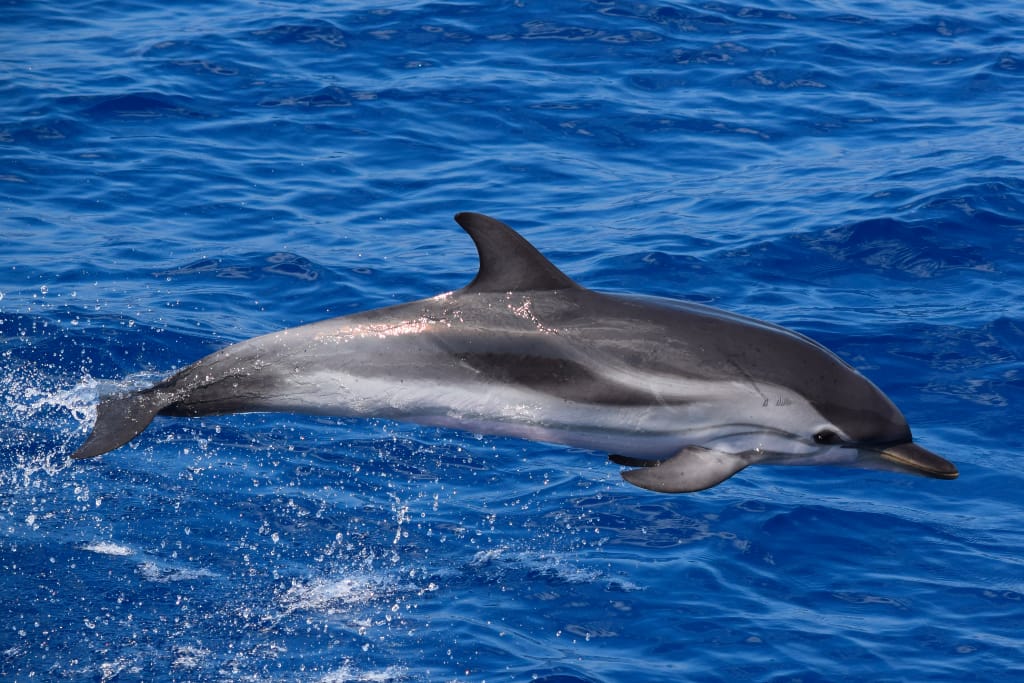

The striped dolphin (Stenella coeruleoalba) has light stripes on the sides that stretch from the eyes to the tail and give this species a special beauty. Length is up to 2.7 meters, weight is about 100–130 kg. Swims very fast, loves to jump. In the waters around Tenerife, it can be seen at any time of the year, although not very often.


The Atlantic spotted dolphin (Stenella frontalis) is slightly smaller in size than the bottlenose dolphin. Adults have a spotted color. They reach a little more than two meters in length and weigh 60–80 kg; they are very active. Groups of the Atlantic spotted dolphins can be observed near Tenerife, mainly during the migration period, from autumn to spring.
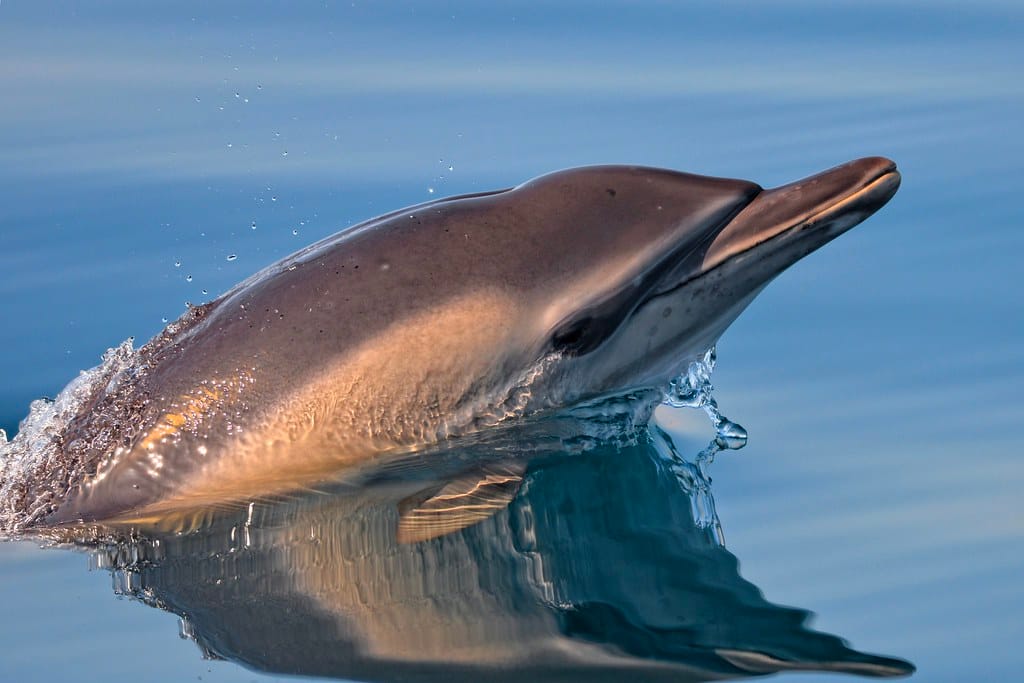

The common dolphin (Delphinus delphis) is the most common species of dolphins in the world. It is easy to identify by the pale yellow stripes on the sides. The back is black or brown-blue, the belly is light. Length is up to 2.5 meters, weight may vary from 80 to 130 kg. They like to play with waves from boats. Around Tenerife, they are found mainly in winter, especially in December and January.
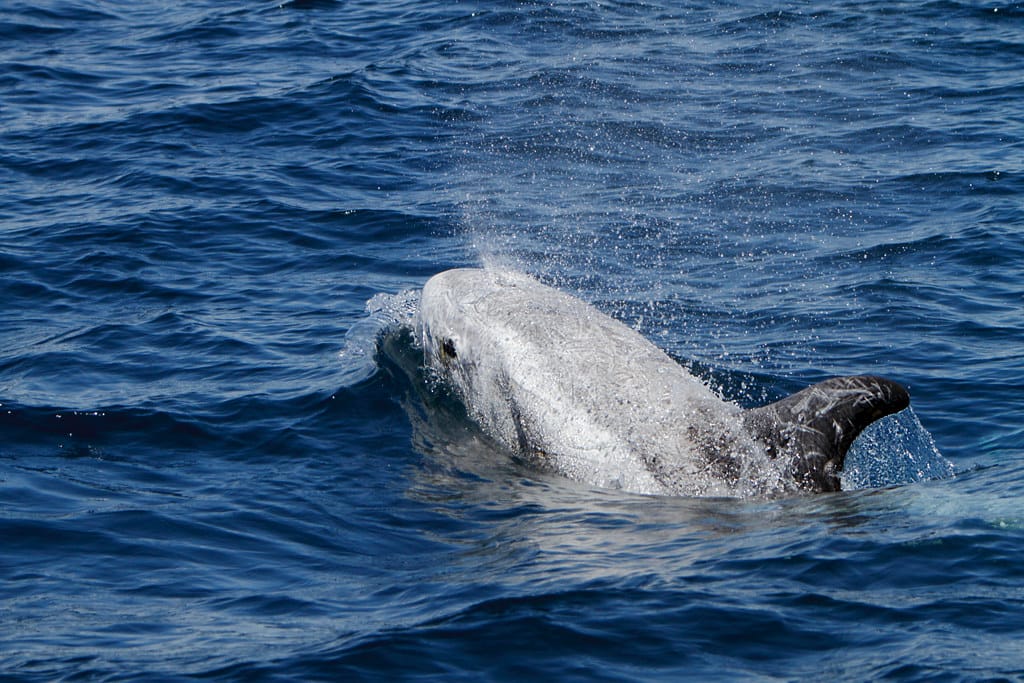

Whale watching (Tenerife boat trips)


The sperm whale (Physeter macrocephalus) is one of the largest mammals on the planet. It is distinguished by a very large head and longitudinal stripes on a dark gray body, similar to wrinkles. Males reach 18–20 meters in length and a mass of 40 tons (and sometimes 60), females can be 11 meters and 15 tons. A small dorsal fin against the background of such sizes seems almost imperceptible. They can dive to a depth of 3 kilometers and spend 35 minutes or more under water. This is one of the reasons why the probability of meeting a sperm whale during a boat trip in Tenerife is quite low: these animals spend a lot of time underwater. It is believed that the chances of seeing them are somewhat higher in the spring.
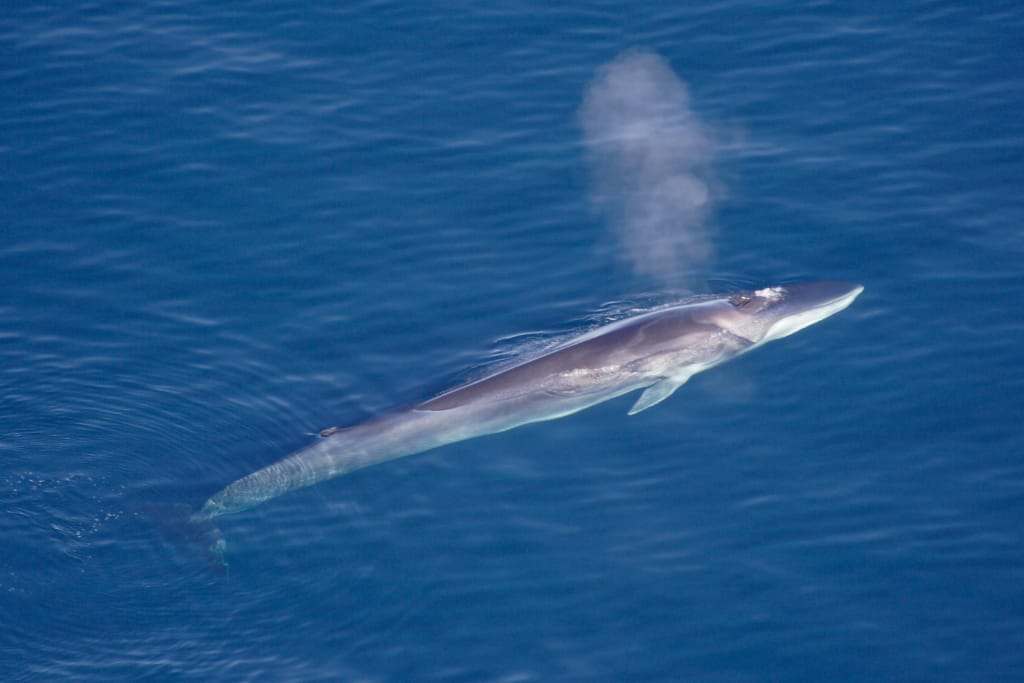

The fin whale, or common rorqual (Balaenoptera physalus) is the second animal on the planet in size (after the blue whale). From behind and from the sides it has a black or dark gray-brown color, gradually turning into white on the belly. The color of the head is asymmetrical: on the right it is light gray, turning into white on the lower jaw; on the left it is darker, turning into dark gray on the lower jaw. The fin whale can reach 27 meters in length (and females are usually longer), weigh from 40 to 70 tons and reach speeds of more than 40 kilometers per hour. They live in groups of 6 to 10 individuals, which makes them more social than other large whales. The probability of seeing a fin whale in the waters surrounding Tenerife is quite low, as they are rarely shown to people. However, the chances are slightly higher in the autumn and winter months.
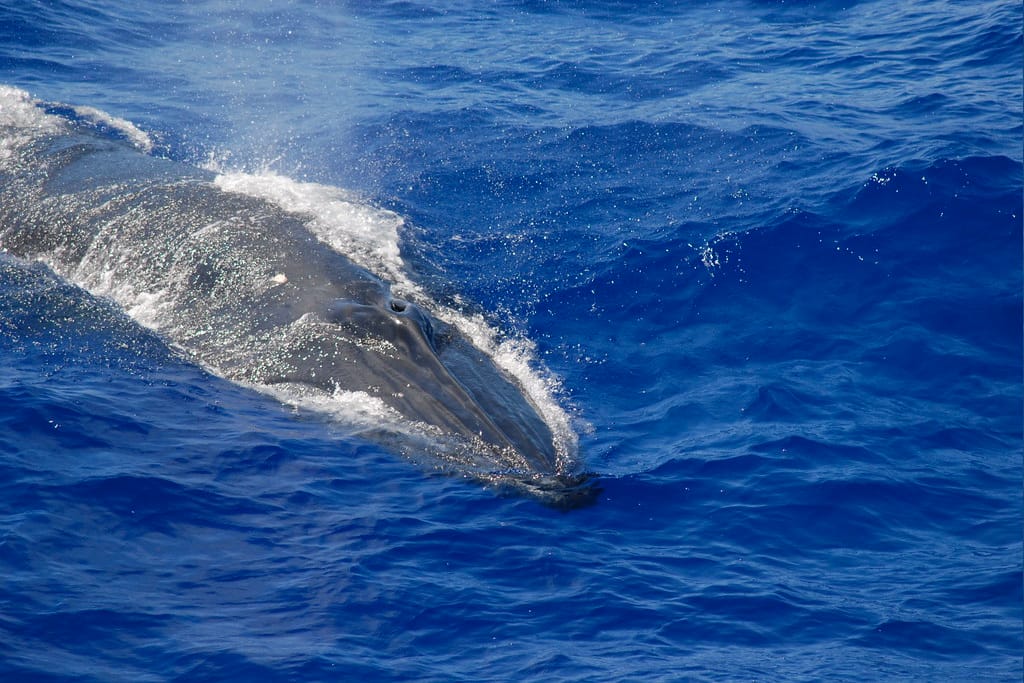

Eden's whale / Bride's whale (Balaenoptera edeni / brydei) are two very similar species, the first of which is somewhat smaller than the second. It is believed that it is the Bride's whale that is found in the Canaries; however, there seems to be insufficient data for an unambiguous answer. The Bride's whale can reach 15 meters in length and weighs up to 25 tons. Females are slightly larger than males. The color of the back is dark blue-gray, turning into lighter on the sides; the throat and belly are light. Three longitudinal ridges are visible on the head. The curved dorsal fin is located far behind, like in all similar species. They live in pairs or small groups. The best months for observation in Tenerife are spring and summer, although the chances of seeing this whale, like other large individuals, are not very great: they are not particularly interested in communicating with people.
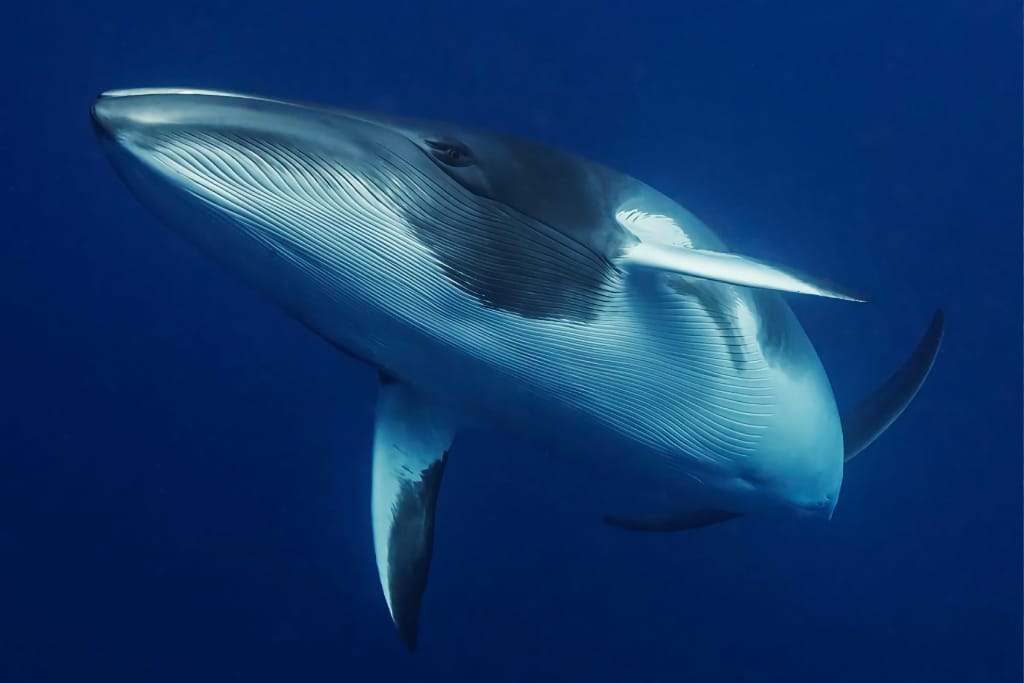

The sei whale (Balaenoptera borealis) may have 17–19 meters in length and a weight of 30 or even 45 tons. They can reach a speed of about 47 kilometers per hour. The back is dark, the sides are gray with small light spots, the belly is from gray to white. It is similar to the Bride's whale, but the sei whale is slightly larger and darker; on a narrower head it has only one longitudinal ridge, not three; the dorsal fin is higher. Dives to a depth of about 300 meters, may not surface for about 20 minutes. They usually live alone. You can meet them near Tenerife during the migration period, from autumn to spring, but it is very difficult to see them, since they almost do not show above the water.
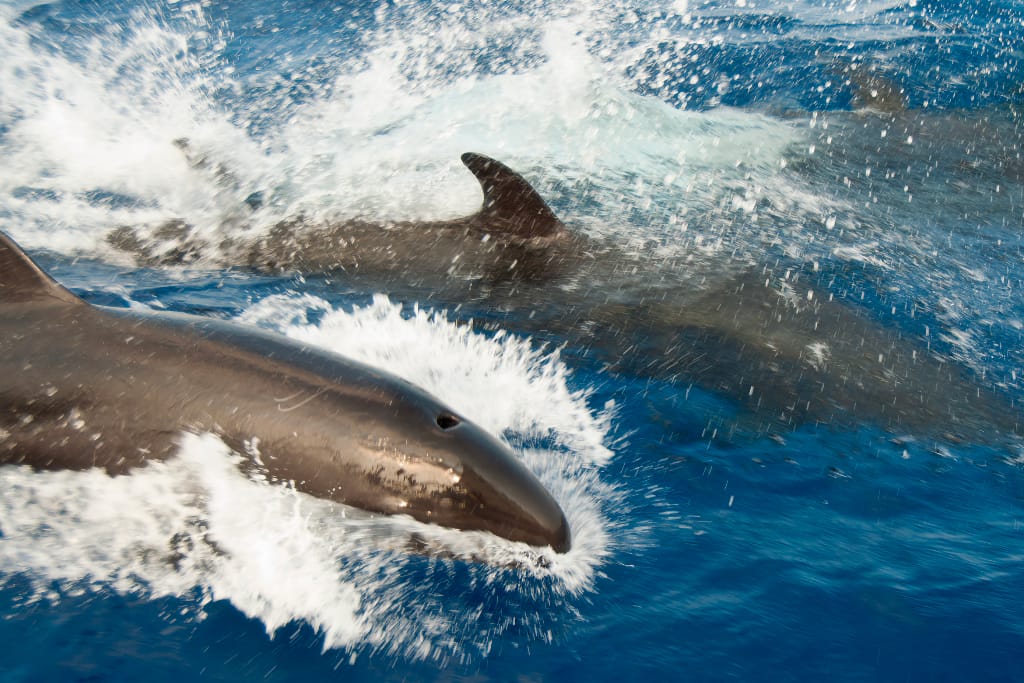

The false killer whale (Pseudorca crassidens) reaches 5.5 meters in length and weighs 2 tons. The dorsal fin can be up to 30 cm in height. Its color is from dark gray to black. The head is rounded, the forehead is in the shape of a melon. They dive to a depth of up to 2 kilometers. False killer whales are very social and sometimes live in groups consisting of hundreds of individuals. The probability of seeing small killer whales near Tenerife is not very high. The greatest chances are in spring or autumn.
Other cetaceans that are very rarely seen around Tenerife (whales and dolphins)
- Blainville's beaked whale or dense-beaked whale (Mesoplodon densirostris)
- Cuvier's beaked whale, goose-beaked whale, or ziphius (Ziphius cavirostris)
- Gervais's beaked whale or Antillean beaked whale (Mesoplodon europaeus)
- Pygmy sperm whale (Kogia breviceps)
- Fraser's dolphin or Sarawak dolphin (Lagenodelphis hosei)
- Blue whale (Balaenoptera musculus)
- Humpback whale (Megaptera novaeangliae)
- Common minke whale or northern minke whale (Balaenoptera acutorostrata)
- Orca or killer whale (Orcinus orca)
FAQ about boat trips in Tenerife
At what time of the year can you see more dolphins in Tenerife? Whale watching season
Most cetaceans migrate near Tenerife in the autumn, winter and spring months, especially from November to February. In spring, there is a greater chance than at other times of the year to see large whales. In summer, the ocean is warmer and there is less food for whales and dolphins, so at this time of year many of them migrate to colder waters.
It is quite easy to meet residents of the Canary waters, bottlenose dolphins and pilot whales, in any season.
At what time of day is it easiest to meet dolphins and whales near Tenerife?
There is no definite answer to this question, so it's up to you!
In the morning, the ocean is usually calmer, and this makes it easier to observe; however, dolphins are usually not very active at this time.
If you want to catch a good light for a photo, sailing at dawn, early in the morning or before sunset can be a good idea.
There are beautiful blue waves during the day, from about 11 to 15 o'clock. At this time, there are often more waves than in the morning, but the animals are also more active.
In the evening, the ocean can be the most restless, and there are fewer dolphins, but their activity is high.
Are boat trips safe for marine life and ecology in Tenerife? Whale and dolphin conservation
In the Canary waters, compliance with special rules that apply to all means of transportation on the ocean is strictly monitored. Especially in the ZEC Teno-Rasca zone, the first whale sanctuary in Europe that stretches along the shores of municipalities Buenavista del Norte, Santiago del Teide, Adeje, Arona and Guia de Isora. Here, on an area of about 70,000 hectares with a length of about 22 kilometers, all kinds of cetaceans that can be found near Tenerife live and migrate. They are attracted here by the great depth between the islands of La Gomera and Tenerife, as well as the biodiversity of these waters, which provides dolphins and whales with food.
Rules for the observation of cetaceans in Tenerife (dolphin boat trip)
- Approach gradually and no more than 60 meters.
- Stay near animals for no more than 30 minutes.
- Go at low speed. Do not change the course and speed abruptly.
- Avoid concentration of boats.
- Leave the observation area if the animals are concerned.
- Take into account the size of the group, the presence of cubs or the mating season, the weather, and so on.
- It is not allowed to chase animals, surround them, navigate towards them in a straight line or cross, go through groups of animals.
- It is forbidden to navigate near cetaceans, feed them, touch or disturb them with sounds.
- It is forbidden to throw garbage into the water.
However, whales and dolphins in Tenerife sometimes out of curiosity approach the boats themselves (in this case, the ship's engine must be turned off). In addition, they like to play with the waves from the boats. So, while we are doing Tenerife dolphin-whale watching... they are watching us!
How exactly and where can you see whales and dolphins? Tenerife yacht rental
To meet marine life in its natural habitat, you need to book a boat trip in Tenerife. The most comfortable option is an individual yacht, boat or catamaran rental (including captain's services).
We will help you to choose the best option for your tour and boat, coordinate the time and other important details. For example, if necessary, we can arrange a transfer for you to the starting point of the tour. Usually, it is Puerto Colon or the port of Las Galletas (Marina del Sur), since it is in the south and southwest of the island, between Tenerife and La Gomera, there are the most suitable conditions for ocean excursions. The depth and climatic features of these waters provide a variety of marine life – it is not by chance that the ZEC Teno-Rasca cetacean reserve is located here. Also, these waters are relatively calm. And, of course, the impressive views of the islands deserve special attention during a tour for dolphin watching.
Los Cristianos is one of the popular tourist spots in Tenerife. It’s not far from both Puerto Colon and Las Galletas, and we will be glad to arrange a transfer for you to one of our vessels (we can offer you yachts, a speedboat or a catamaran).
Tenerife dolphins can often be found relatively close to the shore. However, since we are dealing with wildlife, it is never possible to completely predict such encounters. But you can be sure that an experienced captain will make the best route for you, taking into account your wishes, the season and the weather, as well as all the information available to specialists.
To rent a yacht, choose the most suitable option for you and send us a request via the contact form, or write to us via WhatsApp.
Where does the dolphin trip (Tenerife) start from?
Tours for whale watching: Puerto Colon (Tenerife)
Puerto Colon is a large port in the south of the island, in the resort of Costa Adeje. Whale and dolphin watching tours in Tenerife mostly start from here. There are many good beaches, bars and restaurants nearby, as well as hotels and tourist apartments, so it's not surprising that so many yachts are based in Puerto Colon. In total, it can accommodate up to 355 vessels up to 20 meters long.
It is in Puerto Colon there yachting in Tenerife is most developed. That’s not far from such famous resorts as Las Americas and Los Cristianos. Dolphin boat trip is one of the most popular leisure activities here!
Las Galletas, Marina del Sur (Tenerife): whales and dolphins’ trips
The port in the village of Las Galletas, which is also called Marina del Sur, is another good place to start a boat tour. A lot of ships go out to the ocean from here every day, but, of course, compared to Puerto Colon, this port is much quieter. Marina del Sur has space for 176 vessels up to 20 meters long.
Getting onboard
It is advisable to arrive at the port having some time before the start, so as not to shorten the planned duration of your dolphin excursion (Tenerife). The captain will take you on board and give you a brief explanation, familiarizing you with the boat and safety rules during an ocean trip.
The adventure begins!
What are the chances of seeing whales and dolphins in Tenerife?
During a boat trip along the coast of Tenerife, it is easiest to meet pilot whales. The probability is more than 90 %.
In about four out of five cases, a boat trip allows you to see the bottlenose dolphin (Tenerife, Costa Adeje). Dolphin watching in their natural habitat is a truly unforgettable experience.
Other cetaceans are much rarer and more elusive, so the probability of meeting them depends on many factors. It is almost impossible to predict such a meeting, but it is, of course, possible. So, study our guide above on cetacean species in order to be armed with knowledge and be able to distinguish one species from another, if you are lucky enough to see someone from infrequent guests of ocean trips.
In any case, renting a yacht in Tenerife is an unforgettable and enjoyable experience.
Is it possible to swim during boat trips? Who can be seen underwater?
Swimming in the ocean and snorkeling are included in the program of almost any boat trip in Tenerife. Depending on your wishes, the captain can stop for a swim in a deeper place or in a shallower one.
At a greater depth, you can see an angelshark (flat-bodied shark, similar to a stingray, safe for humans), rays and turtles.
There are 7 species of sea turtles in the world, and 5 of them can be found off the coast of Tenerife. However, most often you can see two types: these are the loggerhead (Caretta caretta) and the green sea turtle (Chelonia mydas). Both of these species can reach one meter in length and weigh of 100–200 kg, but in general, loggerheads can be slightly larger than green turtles. Much less common are the hawksbill sea turtle (Eretmochelys imbricata), the leatherback sea turtle (Dermochelys coriacea, also known as the lute turtle, leathery turtle, the luth) and Kemp's ridley sea turtle (Lepidochelys kempii, the Atlantic ridley sea turtle), which is under threat of extinction.
While snorkeling at shallow depths, you can see mainly small marine life, such as the West Atlantic trumpetfish, the sargo (white seabream), the plain bonito. Sometimes there is also the Mediterranean parrotfish.
What else is included in the cost of a boat trip in Tenerife?
The ocean excursion program and the services included in the price depend on your personal preferences and the vessel you choose. So, part of the excursions implies a free transfer to the port and back (if you need it, of course). The work of the captain, as well as drinks and snacks are always included in the price. If you have special preferences about drinks and snacks during the trip, you must inform us in advance so that we can take into account your wishes.
Before the tour, you will be able to discuss with the captain what you are most interested in: dolphin and whale watching, snorkeling, beautiful views of the rocks, etc. Taking into account his experience, the captain will offer the most suitable option for you.
If you like fishing, you can choose to go on a boat specially equipped for fishing. The hook comes across such species as the red porgy (common seabream), the red seabream, the common pandora, the common two-banded sea bream, the comber, the gilt-head (sea) bream. Tuna, wahoo (a scombrid fish), striped marlin, barracuda can become larger prey. Sometimes even small sharks come across; they are usually released.
Is it possible to arrange a celebration on a yacht in Tenerife?
Yes, of course! We will be happy to help you organize a special yacht trip in Tenerife: birthday, bachelorette party, anniversary, engagement, etc. Be sure to inform the captain about your plans in advance, especially if you count on his help, or you need a special menu or an unusual excursion program. Individual yacht rental (Tenerife) is perfect for celebrations!
Is there any danger in boat trips in Tenerife?
If you are concerned about whether sharks and other dangerous marine animals are present in Tenerife, we can reassure you: local coastal species are usually safe for humans (for example, the angelshark, the houndshark). Dangerous sharks or killer whales are not usually found in the part of the ocean where tours are carried out. They live only at really great depths, far from the coast, so the chances of meeting them during a boat trip tend to zero.
In winter, the basking shark sometimes swims in the Canary waters, absolutely harmless and feeding on plankton.
Moreover, cases of attacks on humans by whales and dolphins are unknown. As for the questions about the fate of people in the stomach of a whale, it is rather from the field of anecdotes: reliable cases of such situations simply do not exist.
In any case, the main rules of safety in the ocean are following the instructions of the captain and respect for marine animals and the environment.
Can seasickness start while sailing on the ocean?
Most often this does not happen. Firstly, this is facilitated by the small size of the vessel, and secondly, in bad weather with strong waves, tours are not carried out at all. But if you have a tendency to motion sickness, it is advisable to take measures in advance: take with you suitable kinetosis medications (e.g. Biodramina) or better take them in advance (30–40 minutes before going out into the ocean). In addition, it is not recommended to take alcohol on the eve of the tour. Food before an ocean excursion should be familiar and easy to digest.
What should I take with me for a boat trip in Tenerife?
First of all, protection from the sun, especially in the case of a morning or afternoon excursion: a headdress (preferably one that will not be blown away by the wind), sunglasses, sunscreen for exposed parts of the body. It is also advisable to take a light windbreaker or something similar with you, since the wind in the ocean can be quite cool. Choose shoes that you are not afraid to get a little wet, if anything. Bathing suits and towels will be useful for ocean swimming. You can also take with you whatever you deem necessary (check with the captain what else may be useful during a tour in your particular case). But, of course, bulky or dangerous items, valuables that can be lost, should not be taken with you on the boat.
Other exciting activities in Tenerife
Tenerife is not only about whale and dolphin watching. The island offers a plethora of other exciting activities and attractions that cater to all tastes and ages. Here's a glimpse of what you can explore:
Siam Park is a must-visit water park in Tenerife, known for its thrilling rides and beautiful Thai-themed architecture. Whether you're an adrenaline junkie or looking for a fun family day out, Siam Park has something for everyone. Don't miss the Tower of Power, a slide that plunges through a shark-filled aquarium!
Mount Teide is Spain's highest peak and a UNESCO World Heritage site. You can hike or take a cable car to the summit for breathtaking views of the Canary Islands. The unique volcanic landscapes and the Teide National Park are a paradise for nature lovers and photographers.
Home to an extensive and diverse reserve of animal and plant species, Loro Parque is another family-friendly attraction. From the spectacular orca shows to the lush botanical gardens, it's a place where education meets entertainment.
Tenerife's golden sandy beaches and clear blue waters are perfect for relaxation and water sports. Try surfing, snorkeling, or simply bask in the sun at popular beaches like Playa de las Américas or Playa del Duque.
Indulge in the local Canarian cuisine, with dishes like "papas arrugadas" and "mojo" sauce. The vibrant nightlife in Tenerife offers a mix of traditional bars, lively clubs, and beachfront lounges.
Explore the rich history of Tenerife by visiting the colonial towns of La Laguna and La Orotava. The well-preserved architecture and charming streets are a window into the island's past.
Tenerife is a destination that offers more than just marine adventures. Whether you're into nature, history, food, or fun, this island has something to captivate your heart.
Yacht rental, whale and dolphin tour (Tenerife): reviews
Ocean excursions in Tenerife are deservedly popular. We will be happy to post your review about a boat trip on a yacht in Tenerife in this section!
